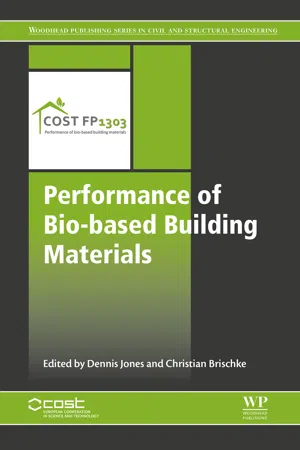
- 650 pages
- English
- ePUB (mobile friendly)
- Available on iOS & Android
Performance of Bio-based Building Materials
About this book
Performance of Bio-based Building Materials provides guidance on the use of bio-based building materials (BBBM) with respect to their performance. The book focuses on BBBM currently present on the European market. The state-of-the-art is presented regarding material properties, recommended uses, performance expectancies, testing methodology, and related standards.Chapters cover both 'old and traditional' BBBM since quite a few of them are experiencing a comeback on the market. Promising developments that could become commercial in the near future are presented as well.The book will be a valuable reference resource for those working in the bio-based materials research community, architects and agencies dealing with sustainable construction, and graduate students in civil engineering.- Takes a unique approach to bio-based materials and presents a broad overview of the topics on relevant areas necessary for application and promotion in construction- Contains a general description, notable properties related to performance, and applications- Presents standards that are structured according to performance types
Frequently asked questions
- Essential is ideal for learners and professionals who enjoy exploring a wide range of subjects. Access the Essential Library with 800,000+ trusted titles and best-sellers across business, personal growth, and the humanities. Includes unlimited reading time and Standard Read Aloud voice.
- Complete: Perfect for advanced learners and researchers needing full, unrestricted access. Unlock 1.4M+ books across hundreds of subjects, including academic and specialized titles. The Complete Plan also includes advanced features like Premium Read Aloud and Research Assistant.
Please note we cannot support devices running on iOS 13 and Android 7 or earlier. Learn more about using the app.
Information
Introduction to the performance of bio-based building materials
† University of Primorska, Koper, Slovenia
‡ Luleå University of Technology, Skellefteå, Sweden
Abstract
Keywords
1.1 Introduction
1.2 Bio-based building materials and their role in the modern building sector
Table of contents
- Cover image
- Title page
- Table of Contents
- Copyright
- List of contributors
- Preface
- Acknowledgement
- 1: Introduction to the performance of bio-based building materials
- 2: Wood as bio-based building material
- 3: Nonwood bio-based materials
- 4: Protection of the bio-based material
- 5: Performance of the bio-based materials
- 6: Performance of buildings
- 7: Test methods for bio-based building materials
- 8: Modelling
- 9: Environmental assessment of bio-based building materials
- 10: Durability, efficacy and performance of bio-based construction materials: Standardisation background and systems of evaluation and authorisation for the European market
- Glossary
- Index